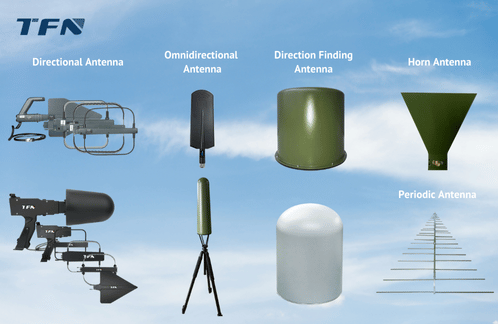How to choose the right antenna for wireless transceiver in RF system?
An antenna is an electronic device used to transmit or receive radio waves. It can convert guided waves (such as electric current) into radio waves, or convert radio waves into guided waves. Choosing the right antenna for wireless transceiver in RF system is a complex process involving multiple technical levels and practical application requirements. The following is a detailed guide, including analysis of key factors, selection steps, etc., to help you choose the right antenna for your RF system.

1. Clarify system requirements and specifications
First, it is necessary to clarify the key performance indicators of the RF system, such as the operating frequency band, transmission distance, signal strength, and coverage. These performance indicators will directly affect the selection and configuration of the antenna. Users can obtain this information from the user manual, technical specifications, or data provided by the manufacturer of the device.
2. Understand the basic types and characteristics of antennas
Antenna is a key component used to transmit and receive wireless signals in the RF system, and its type and characteristics directly affect the communication performance of the system. According to the purpose and characteristics, antennas can be divided into many types, such as transmitting antennas, receiving antennas, omnidirectional antennas, directional antennas, linear antennas, planar antennas, etc. Each type has its specific application scenarios and performance characteristics. For example:
Omnidirectional antenna: radiates evenly in all directions, suitable for scenarios that require coverage in all directions, such as Wi-Fi routers, Bluetooth devices, etc.
Directional antenna: has stronger radiation and reception capabilities in a specific direction, suitable for scenarios that need to send signals to a specific direction or receive signals from a specific direction, such as base station antennas, satellite communication antennas, etc.
3. Pay attention to the key parameters of the antenna
When selecting an antenna, you need to pay attention to the following key parameters:
Frequency range: Make sure that the frequency range of the selected antenna matches the operating frequency band of the RF system.
Gain: Gain indicates the performance of the antenna relative to the standard antenna in a certain direction. A high-gain antenna can increase the communication distance, but it also causes the beam width to narrow. Therefore, it is necessary to select the appropriate gain according to actual needs.
Directivity: Directivity determines the directionality of the antenna radiation and reception signal. Omnidirectional antennas radiate evenly in all directions, while directional antennas have stronger radiation and reception capabilities in one or several specific directions.
Polarization: The polarization mode of the antenna should match the polarization mode of other antennas in the system to ensure good signal transmission. Common polarization modes include linear polarization (horizontal or vertical) and circular polarization (right-hand or left-hand).
Impedance matching: The impedance of the antenna port should match the impedance of the RF system to reduce signal reflection and loss. Typically, wireless transceiver equipment uses an impedance of 50 ohms.
Voltage standing wave ratio (VSWR): VSWR reflects the degree of matching between the antenna and the transmission line system. When VSWR is equal to 1, it indicates perfect matching. At this time, all high-frequency energy enters the antenna and is converted and radiated out, without any energy reflection loss. The closer the VSWR is to 1, the better the matching performance.
4. Consider other considerations such as maintenance
Environmental factors: The actual application environment has an important impact on the selection of antennas. For example, if the device needs to work outdoors or in a harsh environment, you may need to choose an antenna with characteristics such as waterproof, dustproof, and high temperature resistance. At the same time, you also need to consider electromagnetic interference factors in the environment, such as signal interference from other wireless devices and signal blocking by buildings.
Installation location and method: The installation location and method of the antenna will also affect its performance. For example, the installation height, direction, angle, etc. of the antenna will affect the coverage and transmission effect of the signal. Therefore, when selecting an antenna, you need to determine the installation location and method based on the actual application scenario.
Maintenance and care: As one of the key components of the RF system, the antenna needs to be regularly maintained and maintained to ensure its stable and reliable performance. When selecting an antenna, you can consider the convenience of its maintenance and care.
Regulations and compliance: When selecting and using antennas, you need to comply with relevant regulations and compliance requirements. For example, in some countries and regions, you may need to obtain a specific radio frequency license or certification to use antennas in specific frequency bands.
In summary, when selecting a suitable antenna for the wireless transceiver device in the RF system, the user needs to consider a variety of factors. Only in this way can the selected antenna be ensured to meet the performance requirements of the system and show good stability and reliability in practical applications.
TFN has carefully crafted a variety of antennas for RF systems to meet the diverse needs of wireless transceiver equipment and improve communication efficiency and stability.
MOA750 omnidirectional broadband antenna (300MHz-7500MHz)
TF908 directional antenna set (F20: 9kHz-20MHz, F225: 20MHz-250MHz, F250: 200MHz-500MHz, F580: 500MHz-8000MHz)
TM9265 directional antenna set (9KHz-26.5GHz)

If you are interested in TFN's various antenna models, please contact TFN sales team:
Email: info@tfngj.com
WhatsApp: +86-18765219251
Facebook: https://www.facebook.com/tfnfate/
